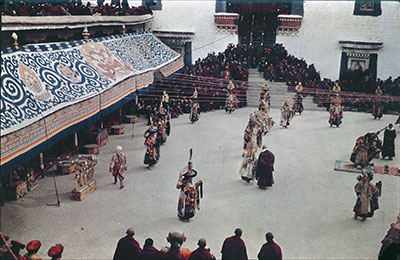
1998.157.80 (Transparency colour)


1998.157.80 (Transparency colour)

Frederick Spencer Chapman
Frederick Spencer Chapman
February 10th 1937
Lhasa > Potala > Deyang shar
1998.157.80
60 x 94
Dancing
Transparency Colour
Donated 1994
Faith Spencer Chapman
British Diplomatic Mission to Lhasa 1936-37
Frederick Spencer Chapman
SC.T.1.80
Technical Information - The transparency has been made in reverse and needs to be flipped to see it the right way round [MS 07/04/2006]
Other Information - Photographer: Chapman and Dr Morgan took photographs of this ceremony from a balcony directly above the entrance to the Eastern Courtyard. This photograph was taken from further along the balcony to the left or from an adjacent one on the same level. This image may be a reproduction from what was originally a colour transparency as there is some evidence in the collection that one of Chapman's colour cameras was set up in this position. This is further supported by the fact that the image has no reference number on the back, which is unusual in Chapman's black and white collection [MS 06/04/2006]
Other Information - Description: "Then comes the serious business of the day. The skeletons scamper away, and the trumpets proclaim the chief actor, a black hat magician who is to lead the remainder of the ceremony. He is dressed in brocade robes embroidered with the dorje thunder bolt and with skulls. He wears an apron of bones and on his head is a tall black hat with an enormous brim and topped by a fan-shaped ornament of peacock's feathers. He dances still to the same rhythm which continues through the whole ceremony, weaving spells with the skull which he holds in one hand and the Dorje which he holds in the other. His movements are fluid and graceful beyond those of the other dancers. Soon a procession of monks appears, bearing censers and sticks of incense abd blowing shrill trumpets. They lead into the dancing floor some 20 black hat dancers dressed like the chief magician but without the bone apron. They slowly dance their way round the court until they are arranged about it in a circle." ['Lhasa Mission, 1936: Diary of Events', Part XIV p.2 , written by Richardson] [MS 06/04/2006]
Other Information - Setting: The “Tse Gutor” masked dances being performed by monks in the eastern courtyard of the Potala. This ceremony takes place at the end of the Tibetan calendar and is designed to purge the sins of the past year. At the Potala it is performed by the monks of Namgye Tratsang who undergo training for many years. Richardson gives a detailed account of this event in “Ceremonies of the Lhasa Year”: “The chief is the Chinese priest Hashang, a huge heavily padded figure in a scarlet robe and with a massive, smiling bald-headed mask. With him are two tiny child-like figures, two more in the dress of Indian sadhus, and two with death’s head masks” (1993:116 – 123) Then two more masked dancers arrive - one representing Shinje the lord of the dead and protector of the Buddhist faith and the other, the stag-headed Tsamuntri. Other dancers portray wrathful protector deities such as Dorje Jigje (with a bull’s head), Tamdrin (the horse-headed), a red masked Mahakala and the black-faced Lhamo. [CH 2003]
For Citation use:
The Tibet Album.
"Black Hat dancers at Tse Gutor"
05 Dec. 2006. The Pitt Rivers Museum.
<http://tibet.prm.ox.ac.uk/photo_1998.157.80.html>.
For more information about photographic usage or to order prints, please visit the The Pitt Rivers Museum.
© The Pitt Rivers Museum